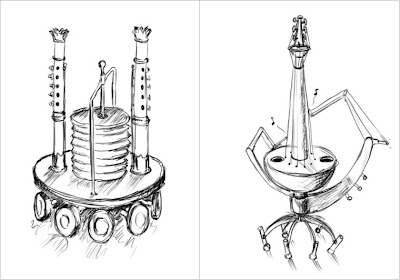Who would’ve thought this “interview with demoscener” would have 4th guest?! (I certainly didn’t, and this fact makes me super happy!) Japan, Hungary, Finland… as you can see from the guest list, demoscene is fairly international culture…
For this time, I interviewed Zavie from Ctrl-Alt-Test, who knows both European and Japanese demoscene. (He is one of the organizers of Tokyo Demo Fest.) In this interview, he reveals his “highly effective” new demomaking technique, not-so-usual working space and what drives demoscene. (He also shares some of his beautiful photo!)
Enjoy! 🙂
——————————————————————–
First of all, could you please introduce yourself briefly?
Hello, my name is Julien Guertault, while in the demoscene people usually know me as Zavie.
By day I work as a programmer and have been doing so for almost ten years now. At this moment I am in the game industry, but this was not always the case. Naturally in the group Ctrl-Alt-Test, which was created four years ago by LLB and I, my role has to do with programming too, although I also try to wear the designer’s hat.
When and how did you find demoscene? And what process did you go through before releasing your first demo?
I think my first contact with the demoscene was around 1995, when I bought a programming magazine that happened to feature an article about the Euskal Party (computer party held in Spain). I had absolutely no idea what this was about and I didn’t quite understand, but I remember running those programs that seemed to serve no other purpose than to show cool stuff on the screen.
It’s only years later, when I was a student around 2002, that I was exposed to the demoscene culture. With a couple of other students we would watch demos, be in awe before “fr-08” , “Mojo Dream” or Conspiracy’s first demo… “BB” was also a popular demo among Linux users.
But it’s in 2009 that I joined the demoscene, when LLB asked me if I’d be interested in forming a group and attending Breakpoint (demoparty held in Germany) a month later. So I really am a newcomer.
I believe your other members reside in Europe. How do you work with them? Is there any specific workflow that you follow?
Back when we were living in the same city, we would gather during weekends to work on our demo, while chatting and having lunch and dinner together. Those are very good memories, but now that we all live in different countries, this time is long gone.
So now it’s all distant work, which has its advantages. For example, working together in a same place is very motivating. But surprisingly, working from different time zones is also very motivating: you get up in the morning and see how the demo has evolved while you were asleep.
We’re experimenting various things but in the end we don’t really have a specific way of working.
That’s interesting. Then let me pick one for example: “F – Felix’s Workshop” I like this demo, because it features many wooden toys and it got soft and warm feel. How did you work on this demo? Did it take much time to create?
“F – Felix’s Workshop” by Ctrl-Alt-Test
Originally, “F” was an idea suggested by LLB: he wanted to make some kind of Animusic like demo. As we were working on the concept we thought merely doing a copy of something created twenty years ago and that looked better already at the time, would be uninteresting. It had to bring something different. So this idea of impersonating the instruments, the story around them and, ultimately, the story of their creator, took shape.
Writing it wasn’t particularly hard, but proved to be very time consuming because our tools are still very rudimentary. So it unfolded over about nine months, although there were periods of less activity than others.
…And this demo was selected in SIGGRAPH real-time live reel this year. Congratulations! 🙂
Hearing that “F – Felix’s workshop” was selected to be shown at the Computer Animation Festival was completely unexpected, and a really good news. I’m quite proud to see our work listed on the SIGGRAPH website.
On a personal level, regardless of what theme or size of demo you’re working on, do you set your own rule or goal? Is there anything you really care about when you make demo?
Not really. We know when it’s done, simply because it’s passed the point we’d be ashamed of having it on big screen, and any additional amount of work would be beyond what we’re ready to invest.
That’s one of the strengths of demomaking compared to other kinds of personal projects: the competitions and demoparties give you a target, a goal. At some point you have to release, then you can move on to the next demo.
(Unfortunately I won’t be able to understand.. but here’s one for readers who makes demo…) What program do you use to make demo? Do you create your own tool?
Our tool-chain is an ever evolving one. Our bread and butter is Visual Studio and a couple of tools from other demoscene people (kb’s soft synth V2, Gopher’s 4klang, IQ’s size coding framework, ryg’s kkrunchy or Mentor and Blueberry’s Crinkler are classics). We don’t use tools like Werkkzeug (demotool provided by Farbrausch) though, we have a more ad hoc approach.
Recently we started writing a tiny tool to make it easier and faster to fine tune some elements. If it proves to work well for us, it might grow into something bigger. I think the key is really to reduce the iteration time: the time it takes between the moment you decide to change something and the moment you see the result.
For our last demo, which is still under development, I wanted to experiment something new. I noticed that even when we think we have a very precise idea of how a demo is going to unfold, after actually writing it some problems appear: holes in the storyline, parts that are boring, scenes that just don’t work…
Writing a demo takes a lot of time, at least for us. Noticing weaknesses in the storyline only after the demo is written is a problem.
So this time I tried to start with writing a storyboard first, just like the ones you see in filmmaking. The idea of having to draw every single scene felt daunting, but it actually proved to be much less work than expected. It was fun even. Just crude sketches of how the scenes would look on screen.
After it was done, I put them together with the music in a preview video. Even though it was very rough, it immediately highlighted the problems of our storyline: scenes that were too long or with too little happening, camera angles that were wrong, scenes that needed to be reordered…
This experiment was a success: with only little work we already knew what was wrong in our storyline and could correct it. So I plan to use this again in the future.
Can’t wait to see that, and be sure to reveal some from your storyboard! 🙂 Ok, um… Could you show us where your demo is born?
What the…? Is this your workspace??
To be honest a significant part of my work on demo is actually done in the train while commuting. I almost always have a notepad with me, which I use to sort my thoughts out and sketch scenes. Most of the story of “D” (D – Four), and many sketches of “F” were born in the train. Sometimes I take my laptop too and code if I am motivated enough. It forces me to do small chunks of work.
“D – Four” by Ctrl-Alt-Test
Mobile office 🙂 But it’s kind of hard to believe that demo was born in the commuter’s train…
Well, a part of it. 🙂 For example these sketches were probably drawn in the train (although I don’t remember for sure).
 |
zavie has shares some drawings and “work in progress” photo on this Pouet thread. |
By the way, that train photo looks great. Aside from demo making, you take beautiful photos on your spare time. Seems like your creative “output” is quite visual, but what about “input”? I mean, how do you nourish your creativity?
It is just as visual. Community websites like Flickr and Vimeo, for example, are an endless source of inspiration. Many very talented people, amateurs and professionals, put their work there for anyone to see. It’s a very good way to learn, and over the years I’ve become more demanding in terms of aesthetics and artistic maturity.
(To see more of his photos, check out his Flickr page.)
Can I ask some ‘personal’ questions? (Obviously this is already personal, but..) You’re originally from France but now you reside in Tokyo. What brings you here?
Simply the opportunity. It was the right time and I could, so I did. I can’t tell you where I’ll be tomorrow, but for now this is where I am.
And how’s Japan treating you? When do you realize “gosh! I’m in Japan now”? (good thing, bad thing, any remarks are fine! I don’t blame you 🙂
It doesn’t happen much anymore, but I remember sitting in the morning train among the so-called “salary men” and “office ladies”, looking around me and thinking to myself: “Boy, I’m on my way to work, IN TOKYO!”.
I suppose living in any country has its pros and cons. In the end, what mostly matters, apart from the obvious basic needs, are the small things, that we often take for granted without realizing they’re part of what makes it pleasing living there. They define how it feels to live there.
And you’re one of the organizers of Tokyo DemoFest. I read your blog post about Tokyo Demo Fest 2013, and it was very interesting to know your take around Japanese demoparty because you know the European demo culture very well. (Didn’t you say you witnessed “Elavated” on live??) What do you think about demo culture in Japan in general?
Yes, Elevated was released at Breakpoint 2009, which happens to be the first demoparty I attended. Somewhere between 500 and 1000 people were in that hall, watching the PC 4k competition, which was really good already, and then, out of nowhere, there was… that.
From the first second, everybody was completely blown away. It was a massive slap in the face for the whole audience. Every once in a while something that wasn’t thought to be possible is shown, and people are excited. But this was a whole new level, this wasn’t even supposed to happen, it was so ridiculously better than everything else, it was unreal, it was amazing.
This feeling fuels the demoscene in my opinion. It is part of why groups take part in competitions, it is part of why people attend demoparties, it is part of why people organize demoparties: to experience that feeling again.
And I believe this is also what fuels the Japanese demoscene. A few enthusiasts took the leap and attended European demoparties, even though the distance, even though the cultural gap, and they experienced it. Now they want to share with people here that feeling of being part of a crowd, of hearing their reaction when it is your work that is being shown for the very first time on big screen.
Starting a new demoparty is a daunting task: everything has to be done. Starting the first demoparty of the country even more so. Yet they did: they found a first location, some sponsors, and spread the word. Fast forward three years later, the last edition of Tokyo Demo Fest was a massive success, and the fourth edition is already on the way. This is something to be proud of in my opinion.
TDF Twitter feed says that next one will be on March 21, 22, 23 in 2014 at the same place as this year. Is this decided?
Yes, absolutely. Friday is a public holiday, so we though it’d be more convenient for Japanese visitors. Also notice next year it’s going to be a three days event!
If you can recommend a few spot in Tokyo or Japan to fellow sceners, where would that be?
Tokyo Demo Fest of course!
😀 …And?
Other than that, Tokyo has a thousand faces, it is a mix of complete chaos and rules followed strictly, a combination of classic and modern architecture, as well as, all too often, just boring functional one. 🙂
Financial districts like Shinjuku West and Shinagawa or crazy neon ones like Shibuya are some must see of course. But I also find the gloomy back streets of Kanda to be very inspiring, especially late at night.
Wow, it IS dark.. 🙂 and it’s quite funny to have this much dark place just a few blocks away from Akihabara (Electric Town)…
Ok, time to shoot this classic question. your favorite demo, memorable demo, demo that changed your life… anything… tell us a demo which is special to you.
I don’t think I have one favorite demo. There are a couple of demos that I love and have watched many times, like “1995” (video) or “You Should” (video) for example, which I both dig for their message.
People wise, I like Preacher‘s simple and candid style, and I am a great fan of the work of Pixtur. He’s very talented and all the demos he’s worked on stand out in terms of direction a visual coherence.
Big question. What is demoscene/demo to you? Why do you make demo?
A part of it is a way of expression, a way of combining orthogonal passions for visual art and computer technique and making sense out of them.
Another part is probably the pursuit of a sense of achievement. You might craft your art, or whatever you’re doing, on your own and maybe get good at it. But without anybody else seeing it, it’s of little use. Releasing a demo means you’re exposing your work to eye of others and accept that they may not like it.
Last but not least, it’s an excellent way to evacuate the frustration one might experience at work. Commercial interests inherently driving work at the office are often incompatible with artistic freedom, and interfere with the technical side too. When making a demo, one has complete freedom, which interestingly brings new problems. 🙂
What type of demo do you want to make in the future? Is there any dream or goal that you want to achieve in the scene?
I don’t think there is such a thing as a dream or goal for me. Demomaking is about art, pursuing something rather personal, honing your skills and exploring your mean of expression. If there were a goal, it would be depressing: what would you do after you reached it? I have a couple of concepts I’d like to try in the future, and surely LLB does too. But by the time we’ll be working on it, we’ll have new ideas we’ll want to explore too.
Then you don’t have to worry about running out of ideas… which is great for us viewers too. Keep it coming 🙂
And finally, your message for demosceners and demo fans out there please.
It’s ok to go to a demoparty without a prod. Even if it’s better to have one. But after attending a demoparty, chances are you will want to make something. A demoparty is a truly inspirational moment, in its most raw form: most people I’ve seen attending their first demoparty wanted to create something right away, and would swear they’d come back with a prod next time.
In that regards, I think demoparties are doing better than many art exhibitions. When was the last time you went to a museum and felt inspired to craft something as a result?
———————————————————————-
Thank you very much Zavie, for taking this interview and allow me to use some of your wonderful photos!!
If you want to want to see more demos from Ctrl-Alt-Test, check out their group site and Pouet demo-graphy. And on his blog, zavie is sharing some resources around demo, 3D rendering and photography. (Plus, on his French blog, you can read what he experiences in Tokyo life… and more.)
Thank you very much for reading! 🙂
———————————————————————-
In case you’re wondering what “demo” or “demoscene” is, better check out the well-made documentary called Moleman2. (and the director, M. Szilárd Matusik’s interview can be read in here.)
#1: q from nonoil/gorakubu is here.
#2: Gargaj from Conspiracy, Ümlaüt Design is here.
#3: Preacher from Brainstorm, Traction is here.
#4: Zavie from Ctrl-Alt-Test is here.
#5: Smash from Fairlight is here.
#6: Gloom from Excess, Dead Roman is here.
#7: kioku from System K is here.
#8: kb from Farbrausch is here.
#9: iq from RGBA is here.
#10: Navis from Andromeda Software Development is here.
#11: Pixtur from Still, LKCC is here.
#12: Cryptic from Approximate is here.
#13: 0x4015 aka Yosshin is here.
#14: Flopine from Cookie Collective is here.
#15: noby from Epoch, Prismbeings is here.
Why I’m interested in demoscene is explained in this article.
And for some of my other posts related to “demo and “demoscene” culture is here.











